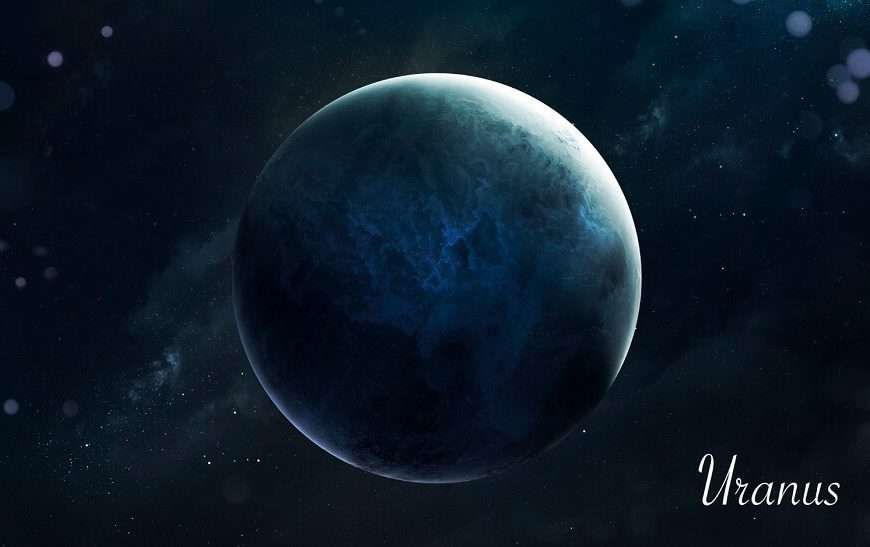‘Why fit in when you were born to stand out?’
This quote by the legendary Dr. Seuss, is a testament to every human being who has wrestled with conforming to society. All because they are ‘different.’
The same can be said of Uranus, the seventh planet from the Sun. Considered the ‘strangest’ planet in our Solar System, it ‘stands out’ on account of its several ‘oddities.’
This article is an attempt to uncover all things about Uranus that you might not discover during a casual conversation. Some people probably know the answer to the question, ‘Which is the coldest planet in our Solar System?’ In case you didn’t know already, it is Uranus.
If you’re looking for answers to further questions, like ‘How many Moons does Uranus have?’, to ‘What Colour is Uranus?’, you will find them right here.
Let’s get started, with a look at the planet’s physical features.
Uranus: Its Physical Features
Uranus is one of those planets that are nicknamed The Gas Giants. As the name suggests, it is composed mainly of ‘gases.’ Namely, Hydrogen and Helium.
Interesting Fact: The bluish colour of Uranus can be attributed to the presence of Methane that is present in the planet’s atmosphere, albeit in small amounts.
Did you know that you cannot stand on Uranus, as is the case with the other Gas Planets? That being said, underneath all that gas is a small region composed of burning hot liquid.
If you’re looking to answer the question ‘Does Uranus have Rings?’, the answer is ‘Yes.’ One must bear in mind that these are not ‘distinct’ rings, like the ones that surround Saturn. Instead, they are narrow rings that are composed of dark material of some kind.
Uranus: Its Moons
Now we’re getting to the more interesting part! Time to answer the question, ‘How many Moons does Uranus have?’
The answer is an emphatic ‘27’! Yes, if you thought that 1 moon was enough for a planet, it’s time to do a rethink. There’s an interesting story behind the names of some of these moons. Did you know, they were named after magical spirits that were the principal characters in some great works of English literature? Like in William Shakespeare’s epic, ‘A Midsummer Night’s Dream’?
Cool Fact: Not only Shakespeare’s, but even Alexander Pope’s works, have been looked up to for sourcing inspiration, vis a vis naming newly discovered moons. A fine tradition that continues to this day.
Some classical examples of these would be the moons Oberon and Titania. Discovered by Herschel way back in the year 1787, they are the largest moons of Uranus.
An additional 10 moons of Uranus were discovered in 1986. Juliet, Puck and Ophelia are a few of these moons. Again, names sourced from the classics, unlike in the past when moons were largely named after figures from Greek or Roman mythology.
Another cool fact: Spotting some of the other moons to bring the tally to 27, was a tad difficult. That was because they were almost 3 billion miles away, and not very large in size.
Uranus Decoded: Fun Facts about the Coldest Planet
It’s time to ‘Up our Knowledge Quotient’, of this most unusual planet in our Solar System.
Presenting some fun facts about Uranus, that both you and your child will love to know!
#1. It was the first planet to be officially discovered!
John Flamsteed might have been the first person to record Uranus way back in 1690. However, it was the observations of Sir William Herschel that officially saw Uranus being classified as ‘a Planet.’
#2. It is Blue in colour
Earlier in this article, we answered the question ‘What Colour is Uranus?’, attributing it to the Methane in its atmosphere. But how does that make it Blue? Here’s how it works. The methane absorbs the Sun’s light, and then reflects the blue light from it, back into Space!
#3. Its origins date back to 4.5 billion years ago
This is also the time when the rest of our Solar System came into existence, on account of The Big Bang. Interestingly, the planet Neptune was formed in much the same way.
#4. It is also made of Ice!
Gas is not the only thing that Uranus is made of. Ice, too, forms a principal constituent of the planet’s fabric. Therefore, it’s not wrong to christen it a ‘Ball of Gas and Ice.’
#5. It is the Coldest planet for a reason
While we know the answer to the question, ‘Which is the coldest planet in the Solar System’, do we know why Uranus gets that title? Perhaps one of the reasons is, Uranus emits very little of the heat that is left from its formation, unlike the other planets in the solar system. This is a mystery, something that has left scientists baffled to this day.
#6. Voyager 2 was the only spacecraft to whiz past Uranus
It made its journey past the planet, from a distance of 81,500 kilometres. Thanks to it, we got our first close-up images of Uranus, as well as its rings and even moons.
#7. ‘Georgium Sidus’ was the first ever name, that was proposed for Uranus
It was its inventor William Herschel who proposed the same, wanting to name it after King George the Third. However, the planet was finally named Uranus, after a Roman God, as was the norm in those days.
#8. You can see Uranus with the naked eye
Perhaps the fact that Uranus was born to ‘stand out’, is the reason we can see it without a telescope! Note: To see Uranus, the night sky would have to be pitch black. Further, one would have to know exactly where to look!
At EuroKids, we believe that teaching your kids about the planet Uranus is an absolute must. After all, it was the First Planet to be discovered in our Solar System. Starting with Uranus, have them embark on a greater journey. Namely, the exploration of the entire Universe!















